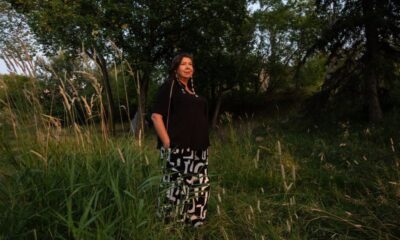Top Stories
Cree of Eeyou Istchee Reflect on Hydroelectric Project’s Impact

UPDATE: The Cree community of Eeyou Istchee is urgently reflecting on the profound impacts of the James Bay and Northern Quebec Agreement (JBNQA) as they mark its 50th anniversary. Despite economic development, many in the community express deep concerns over the environmental and social consequences of hydroelectric projects that have reshaped their land.
The Cree of Fort George, once a vibrant community, now stands largely abandoned, highlighting the JBNQA’s lasting effects. A recent visit by residents Margaret and Johnny Fireman reveals how this once-thriving island, located just across the river from Chisasibi, has become a symbol of loss.
During their ferry ride, the Firemans observed how nature has overtaken the remnants of gardens and structures, including the Fort George Residential School. “We never had to ask permission,” Margaret recalled about her childhood, emphasizing the freedom and safety once experienced in their community.
However, the idyllic life on Fort George was shattered following the 1975 JBNQA. As construction on hydroelectric dams along the La Grande River accelerated, the community faced a dire threat. The Robert-Bourassa generating station was operational by October 1979, doubling the river’s current and heightening erosion risks for Fort George.
In a panic, local authorities ordered the evacuation of nearly 2,000 residents. “There was a lot of confusion,” Margaret stated, describing the haste of the relocation. Many families had to leave behind their possessions, resulting in emotional trauma that still lingers.
Chief Daisy House of Chisasibi, who experienced the relocation as a child, emphasized the ongoing impacts of hydro development. “The trauma from relocation… changed our way of life,” she said. House advocates for community involvement in future development, highlighting a shift towards collaboration with provincial authorities.
The effects of this hydroelectric project extend beyond the abandonment of homes. The La Grande River, once a lifeline for the Cree, has been transformed. Traditional hunting grounds have been submerged, and mercury contamination has forced the community to abandon traditional food sources. “I know that a lot of people don’t know where their electricity comes from,” Margaret lamented, calling for greater awareness of the environmental consequences of hydro development.
Despite the challenges, hope persists. The Firemans noted a new cabin being built on Fort George, symbolizing resilience and continuity among the next generation. As Daisy House articulated, the Cree are not against development but seek sustainable practices that respect their history and land.
As this poignant reflection on the JBNQA unfolds, the Cree community calls for broader recognition of their struggles and the lasting impacts of hydroelectric projects on their way of life. With significant anniversaries like this one, the need for dialogue and healing remains urgent.
For updates and continued coverage on this story, stay tuned as the Cree community navigates their past and shapes their future.
-

 World4 months ago
World4 months agoScientists Unearth Ancient Antarctic Ice to Unlock Climate Secrets
-

 Politics5 days ago
Politics5 days agoSecwepemc First Nation Seeks Aboriginal Title Over Kamloops Area
-

 Entertainment4 months ago
Entertainment4 months agoTrump and McCormick to Announce $70 Billion Energy Investments
-

 Lifestyle4 months ago
Lifestyle4 months agoTransLink Launches Food Truck Program to Boost Revenue in Vancouver
-

 Science4 months ago
Science4 months agoFour Astronauts Return to Earth After International Space Station Mission
-

 Technology2 months ago
Technology2 months agoApple Notes Enhances Functionality with Markdown Support in macOS 26
-

 Top Stories1 month ago
Top Stories1 month agoUrgent Update: Fatal Crash on Highway 99 Claims Life of Pitt Meadows Man
-

 Sports4 months ago
Sports4 months agoSearch Underway for Missing Hunter Amid Hokkaido Bear Emergency
-

 Politics3 months ago
Politics3 months agoUkrainian Tennis Star Elina Svitolina Faces Death Threats Online
-

 Politics4 months ago
Politics4 months agoCarney Engages First Nations Leaders at Development Law Summit
-

 Technology4 months ago
Technology4 months agoFrosthaven Launches Early Access on July 31, 2025
-

 Top Stories3 weeks ago
Top Stories3 weeks agoFamily Remembers Beverley Rowbotham 25 Years After Murder


















